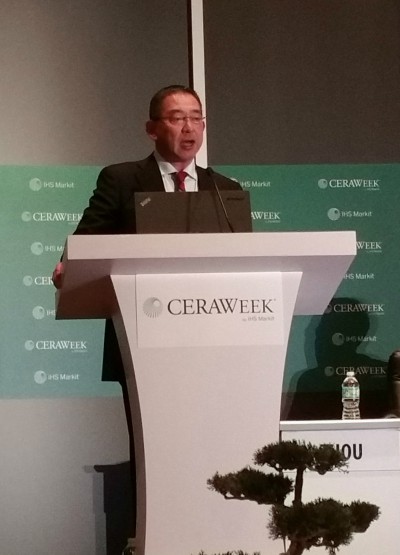CERAWeek '17: Gas execs, analysts discuss Asian LNG market reforms
By Adrienne Blume, Editor
HOUSTON—At a Wednesday morning breakfast panel discussion at CERAWeek by IHS Markit, executives from Asian and US LNG companies, as well as analysts and government strategists, spoke about the state of the Asian LNG market and how reforms should be implemented.
 |
| Photo by Adrienne Blume. |
Panelists included moderator Xizhou Zhou, Senior Director of Research and IHS Markit; Katsumi Kuroda, Senior Advisor at Cheniere Marketing Ltd., who delivered welcome remarks; Shenyuan Ma, Vice President of ENN Group Co.; Hiroki Sato, Chief Fuel Transactions Officer and Senior Executive Vice President of JERA Co. Inc.; Ronggo Kuncahyo, Advisor to the Minister at Indonesia's Ministry of Energy and Mineral Resources; and Harry Park, Head of LNG Business Development and Executive Vice President of SK E&S.
In his welcome remarks, Mr. Kuroda (pictured) said that many alliances on both the buyer and seller sides of the gas market are being seen, particularly in Asia. These alliances may help support future growth in demand from the Japanese and Chinese markets, after the fluctuating growth seen in the past few years.
China moves to deregulate its gas market. Mr. Ma of ENN discussed trends in China's gas market. In its 13th 5-yr plan, the Chinese government has set ambitious targets for gas growth of 10% to 16% over the next 5 yr. Alongside this initiative, China is implementing more serious environmental protection policies, particularly with regard to control of coal use, clean energy use and smog pollution control.
Mr. Ma acknowledged that although monopolies are still active in China, market deregulation is ongoing. Policy implementation will determine the direction of market growth. Deregulation is being seen in the form of the establishment of gas trading centers in Shanghai and Chongqing, as well as greater third-party access to pipeline networks and LNG receiving facilities. At present, China has 12 LNG regasification terminals in operation.
Adjustments are also being made to the gas pricing mechanism. China's free LNG market of more than 10 MMtpy competes with LPG and other fuels. With regard to emerging players and competition, national oil companies will still be dominant for some time. According to Mr. Ma, small and private players will have limited space for business growth over the near term, and mainly in unconventional gas and coal gas.
However, private companies are expected to become increasingly involved in LNG terminal developments and capacity booking, into the future. LNG import and trading will be key areas for private companies to grow over the next few years as improved third-party access policies are implemented, Mr. Ma said.
Consolidation in Asian markets. Mr. Sato of JERA next spoke about fragmentation vs. consolidation in Asian LNG markets. A supply glut through 2023 will push LNG into "sink" markets and force the shut-in of liquefaction plants, as well as create new demand.
Europe will act as the near-term LNG sink, while Asian demand will continue to dominate the LNG market. JERA anticipates global LNG demand to grow by approximately 45% by 2020. Contributing to this growth will be improved buyer-side cooperation and aggregation, price convergence in the global market, the introduction of a market price index in Asia, new concepts in financial schemes to support emerging-market players, and the development of small-scale gas demand.
Mr. Park of SK E&S agreed that price transparency is needed. He noted that gas pricing will still be dominated by oil-linked pricing over the near term, but that it will start to change as LNG requires its own pricing benchmark in the future.
Representing one of emerging Asia's future gas centers, Mr. Kuncahyo of Indonesia's Ministry of Energy and Mineral Resource reported that large gas reserve projects are ongoing in Indonesia. Goals for gas utilization include supporting energy sufficiency and security and fulfilling national energy mix targets. Gas is expected to account for 30% of the country's national primary energy mix by 2025, the advisor said.

- ExxonMobil halts 1-Bft3d blue hydrogen project in Texas
- Aramco and Yokogawa commission multiple autonomous control AI agents at Fadhili gas plant
- Ukraine will resume gas imports via Transbalkan route in November
- Mitsubishi to inject $260 MM into Brunei LNG project
- Freeport LNG (U.S.) on track to take in more natgas on Thursday after unit outage



Comments